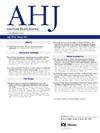Effects of angiotensin-neprilysin inhibition in women vs men: Insights from PARAGLIDE-HF
IF 3.7
2区 医学
Q1 CARDIAC & CARDIOVASCULAR SYSTEMS
引用次数: 0
Abstract
Background
Sub-analyses of key trials suggest a preferential benefit for specific heart failure with preserved ejection fraction (HFpEF) therapies in women. This work investigated treatment effects between women and men in the PARAGLIDE-HF (Prospective comparison of ARNI with ARB Given following stabiLization In DEcompensated HFpEF) trial.
Methods
In this prespecified subgroup analysis, we examined outcomes according to sex in the PARAGLIDE-HF trial. The primary endpoint was time-average proportional change in amino terminal pro-B type natriuretic peptide (NT-proBNP) from baseline through Weeks 4 and 8. We also examined secondary outcomes and tolerability.
Results
Overall, 242 women (52%) and 224 men (48%) were randomized. Women had significantly higher LVEF, worse renal function, and less comorbidities than men. In the overall population, the time-averaged reduction in NT-proBNP was significantly greater for sacubitril/valsartan (sac/val) than valsartan (ratio of change 0.85, 95% CI, 0.73-0.999). When examined according to sex, the time-averaged reduction in NT-proBNP was numerically greater with sac/val in both women (ratio of change = 0.86, 95% CI, 0.69-1.070) and men (ratio of change 0.84, 95% CI, 0.67-1.05) with no differential treatment effect (P interaction = .91). Similarly, the secondary hierarchical endpoint favored sac/val over valsartan in both women and men but was not statistically significant. Study drug dosage levels were similar across women and men and there were no sex-specific differences in the incidence of adverse events.
Conclusions
In patients with mildly reduced or preserved EF >40% and a recent worsening HF event, the efficacy, safety and tolerability of sac/val vs valsartan were similar in both women and men, suggesting consistent effects across appropriately selected patients regardless of sex. Future prospective studies are needed to further evaluate sex-specific differences in treatment response of HFpEF therapies.
Trial registration
Prospective comparison of ARNI with ARB Given following stabiLization In DEcompensated HFpEF; NCT03988634; https://www.clinicaltrials.gov/study/NCT03988634.
血管紧张素-肾上腺素抑制对女性和男性的影响:来自PARAGLIDE-HF的见解。
背景:关键试验的亚分析表明,保留射血分数(HFpEF)治疗女性特定心力衰竭有优先获益。本研究调查了PARAGLIDE-HF (ARNI与失代偿HFpEF稳定后给予ARB的前瞻性比较)试验中女性和男性的治疗效果。方法:在这个预先指定的亚组分析中,我们根据性别检查了PARAGLIDE-HF试验的结果。主要终点是氨基末端前b型利钠肽(NT-proBNP)从基线到第4周和第8周的时间平均比例变化。我们还检查了次要结局和耐受性。结果:共纳入242例女性(52%)和224例男性(48%)。女性的LVEF明显高于男性,肾功能较差,合并症较少。在总体人群中,sacubitril/valsartan (sac/val)组NT-proBNP的时间平均降低显著大于缬沙坦组(变化比0.85,95% CI:0.73-0.999)。当根据性别进行检查时,在女性(变化比=0.86,95% CI: 0.69-1.070)和男性(变化比= 0.84,95% CI: 0.67-1.05)中,NT-proBNP的时间平均降低在数值上更大,没有差异治疗效果(P相互作用=0.91)。同样,在女性和男性中,二级分级终点更倾向于囊/val而不是缬沙坦,但没有统计学意义。研究药物剂量水平在女性和男性之间相似,不良事件发生率没有性别特异性差异。结论:在EF轻度降低或保留40%且近期心衰事件恶化的患者中,sac/val与缬沙坦在女性和男性中的疗效、安全性和耐受性相似,这表明在适当选择的患者中,无论性别,效果都是一致的。未来的前瞻性研究需要进一步评估HFpEF治疗反应的性别特异性差异。试验注册:ARNI与失代偿HFpEF稳定后给予ARB的前瞻性比较;NCT03988634;https://www.Clinicaltrials gov /研究/ NCT03988634。
本文章由计算机程序翻译,如有差异,请以英文原文为准。
求助全文
约1分钟内获得全文
求助全文
来源期刊

American heart journal
医学-心血管系统
CiteScore
8.20
自引率
2.10%
发文量
214
审稿时长
38 days
期刊介绍:
The American Heart Journal will consider for publication suitable articles on topics pertaining to the broad discipline of cardiovascular disease. Our goal is to provide the reader primary investigation, scholarly review, and opinion concerning the practice of cardiovascular medicine. We especially encourage submission of 3 types of reports that are not frequently seen in cardiovascular journals: negative clinical studies, reports on study designs, and studies involving the organization of medical care. The Journal does not accept individual case reports or original articles involving bench laboratory or animal research.
 求助内容:
求助内容: 应助结果提醒方式:
应助结果提醒方式:


